The Apple iPad Review (2012)
by Vivek Gowri & Anand Lal Shimpi on March 28, 2012 3:14 PM ESTThe Display: In Numbers
Apple is very big on maintaining a consistent experience between its products. We see this a lot in our Mac reviews where it's not unusual to see similar white points across virtually all Apple products. It's no surprise that the with the move to the Retina Display Apple wanted to retain as much of the original iPad's display characteristics as possible. We'll start with an analysis of brightness and contrast, both of which remain relatively unchanged from the iPad 2:
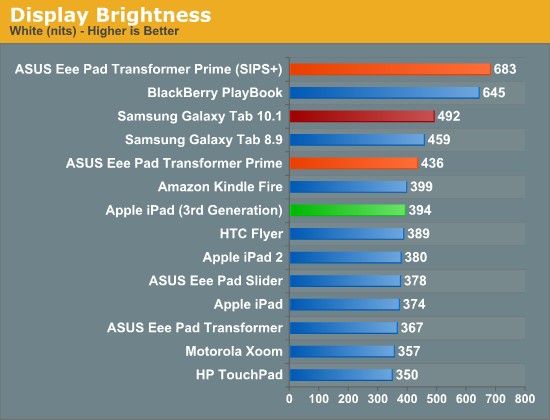
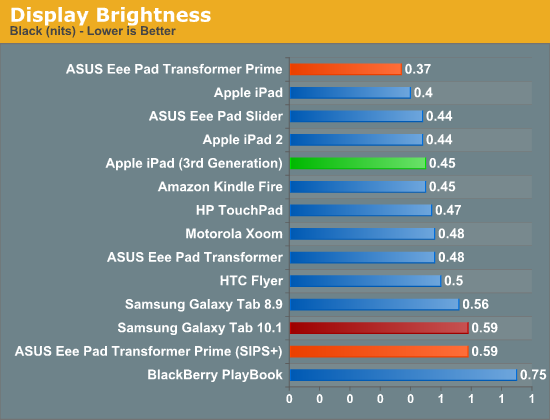
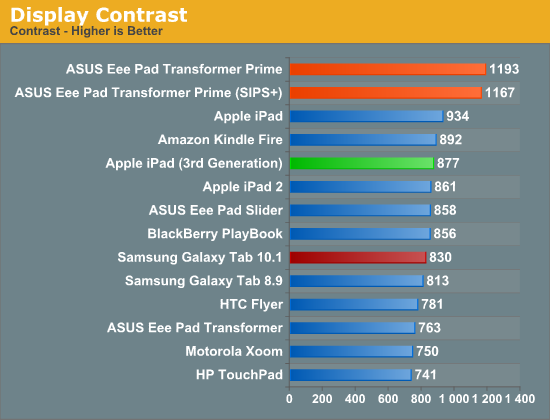
Apple is expected to have triple sourced panels for the new iPad, so you can expect to see variation in these results but for the most part you can expect the new iPad's display to perform similarly to the previous model.
Despite similar brightness and contrast to the previous model, the new iPad offers remarkably better color gamut and color reproduction than its predecessor. Relative to other tablets, the iPad's display is spectacular.
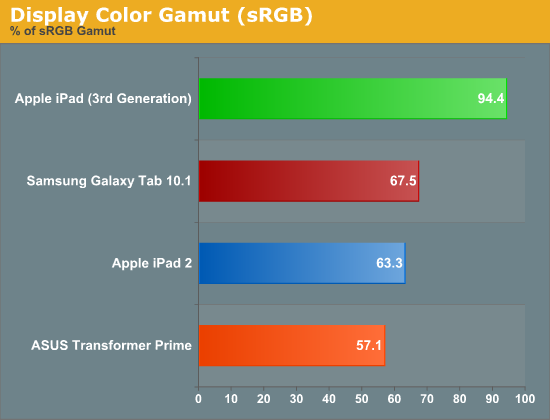
As we mentioned in our Retina Display analysis, Apple delivered on its claims of a 44% increase in color gamut. The new iPad offers nearly full coverage of the sRGB color space and over 60% of the Adobe RGB gamut:
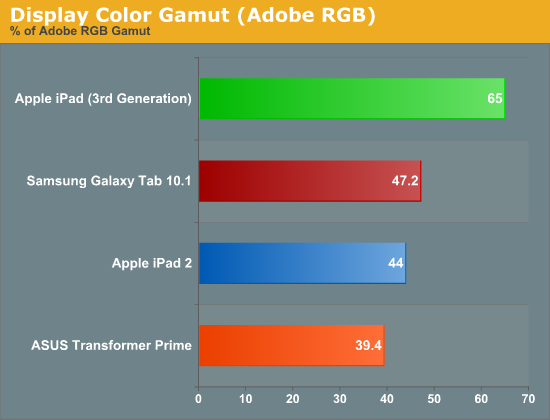
Below is the CIE diagram for the new panel with an sRGB reference plotted on the same chart so you can visualize the data another way:
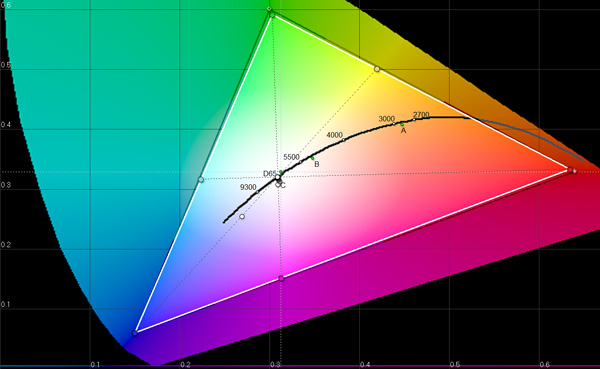
Color accuracy has improved tremendously if we look at delta E values for the primary and secondary colors:
Remember from our display reviews, lower delta E values indicate greater color accuracy. Values below 4 are typically considered good and you can see that the iPad 2 as well as the Transformer Prime both fell short in this department. With the new iPad Apple has clearly focused on color accuracy, which makes sense given it was used as the vehicle to introduce iPhoto for iOS.
Apple still has a lot of work ahead of itself to really put forth a professional quality display in a tablet, but for now the Retina Display is easily the best we've seen in a tablet and a tremendous step forward.
What's most absurd about the iPad's Retina Display is that you're able to get this resolution and panel quality in a $499 device. While we must be careful not to give Apple too much credit here as Samsung, Sharp and its other display partners clearly make the Retina Display, it's obvious that Apple has really been pushing its partners to develop solutions like this.
The biggest problem in the production of any commoditized component is the primary motivation for innovation is to lower cost. For years I argued with notebook PC makers to use higher quality LCD panels but no one was willing to commit to the quantities that would lower costs enough. I was also told that as soon as you put these notebooks on shelves at Best Buy, users wouldn't really care whether they were getting a high quality IPS display or not—all that mattered was the final price.
Apple, under the leadership of Steve Jobs, had a different mentality. Steve's pursuit was quality and experience, cost was a secondary concern. Through slow and steady iteration of this approach, Apple was able to build up a large enough customer base and revenue to be a significant force in the industry when it came to driving costs down. Apple can easily fill your fabs and eat all that you can produce, but you'll have to do whatever it wants to get the order.
Apple's behavior since it got rich has been to drive down the cost of higher quality components, LCDs being a perfect example. Unfortunately other companies don't benefit as much here as Apple tends to buy up all of the production of what it has pushed to create. That's one reason why, although ASUS was first to introduce a 1080p Transformer Pad, it won't launch until well after the new iPad. From what I've heard, the panel makers are all busy servicing Apple's needs—everyone else comes second.
Eventually the entire industry will benefit and all indications point to Apple doing something special for "pro" users in the notebook space next. As I've said previously, Apple has raised the bar with the iPad's Retina Display. The time for average display quality in a $500 tablet is over, the bar has been raised. It remains to be seen whether or not Apple will be able to maintain this quality across all suppliers of its Retina Display. On the iPhone Apple has been entirely too lax about maintaining consistency between suppliers. If it wants to be taken seriously in this space Apple needs to ensure a consistent experience across all of its component vendors.

















234 Comments
View All Comments
jjj - Wednesday, March 28, 2012 - link
Testing battery life only in web browsing ? Maybve that would be ok for a 100$ device.As it is the battery tests are prety poor,you do video playback when every SoC out there has a dedicated decode unit and that test is only representative for vid playback.Here the most important test should have been battery life when both GPU and CPU are loaded and not including that seems like an intentional omission to avoid makiing the device look bad.There are a lot of other things to say about the review,too many but one thing has to be said.
This is a plan B or plan C device.The screen is the selling point,is what had to go in,they didn't had 28/32nm in time and had to go for a heavier,thicker,hotter device with a huge chip (CPU speed is limited most likely by heat not so much power consumption,ofc both are directly related).Apple had to make way too many compromises to fit in the screen,no way this was plan A.
tipoo - Thursday, March 29, 2012 - link
I would have liked a gaming battery life test as well.PeteH - Thursday, March 29, 2012 - link
Beyond even that, I'd like to see a worst-case battery life (i.e. gaming, max brightness, LTE up, etc).Also, it'd be really interesting to see how brightness impacts battery life. Maybe the web browsing test at 20%, 40%, 60%, 80%, and 100% brightness. Of course that would probably delay the review by several days, so it might not be worth it.
Anand Lal Shimpi - Thursday, March 29, 2012 - link
We did a max brightness test, however a gaming test would be appropriate as well. I will see if I can't run some of that in the background while I work on things for next week :)Take care,
Anand
SimpleLance - Wednesday, March 28, 2012 - link
The biggest drain for the battery comes from the display. So, if the iPad will be used for hotspot only (with display turned off), you will get a lot of hours from it because it has such a huge battery.But then, using the the iPad just for a hotspot would be a waste of that gorgeous display.
Very nice review of a very nice product.
thrawn3 - Wednesday, March 28, 2012 - link
Am I the only one that feels the max brightness is more important in day to day use of a highly portable device than DPI and color accuracy?I absolutely would love to have all of these three be excellent but I think for a tablet or small laptop Max Brightness and DPI are higher priority than color accuracy. This is exactly what the ASUS Transformer Infinity is supposed to be but I would prefer it on a real laptop.
I care about color accuracy too but I am perfectly fine with needing a desktop monitor and trading brightness there since it is in a stable environment until we hit the technological level that will allow all these elements to be combined. Maybe quantum dot display technology in the future?
One thing I have to give all these new displays is that they FINALLY have gotten the wide viewing angles thing right and I will be so happy to get this into the rest of the market.
seapeople - Tuesday, April 3, 2012 - link
Would you really prefer a bright 1366x768 TN panel with 200 contrast ratio on a 15" laptop over a less bright IPS Ipad screen with much better resolution, DPI, color accuracy, and viewing angle?vision33r - Wednesday, March 28, 2012 - link
The screen is really gorgeous when you shoot raw with any DSLR and view it in iPhoto.ol1bit - Wednesday, March 28, 2012 - link
I just bought a Asus Transformer Prime, and your review was spot on with what I decided. I can not live with IOS and using Android for 3 years.Just the simple stuff was my decision:
1. Freedom of Android, file transfers, etc. No Itunes requirement.
2. MicroSD
3. Kewl keyboard
4. Live Wallpaper.
5. A real desktop, separate from my applications.
6. 32GB versus 16GB
7. Gorilla Glass (yes, true. My original droid lived in my pocket 2 years no scratches, my HTC Rezound scratches the first 2 weeks).
8. Asus (love their MBs)
9. Nivida (love their GPUs)
What I will miss:
1. Ipad 3 Display.
darkcrayon - Thursday, March 29, 2012 - link
1. iTunes is no longer ever needed for an iOS device. I consider the option of a first party desktop sync solution to be an advantage now that it's not a requirement.7. It seems likely the new iPad uses Gorilla Glass or Gorilla Glass 2...
9. Odd that you'd love nVidia's GPUs when they've been pretty much the bottom of the performance barrel for ARM device graphics, even excluding Apple's SoCs (which have lately been using the fastest GPUs in the industry by far).